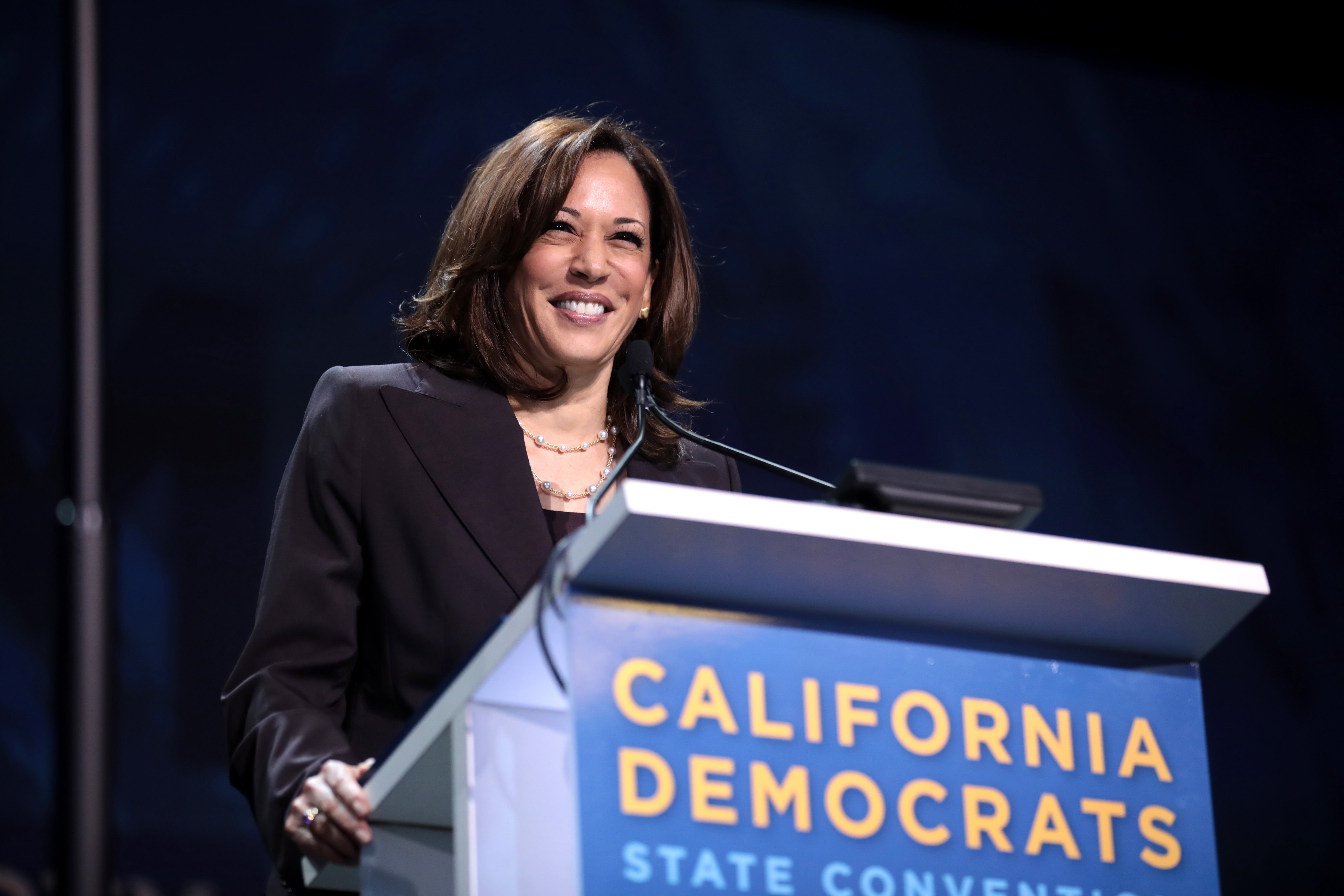Analyzing results, implications of the Harris-Trump White House race

(Elizabeth Engeda/Daily Bruin and Helen Sanders/Daily Bruin)

By Tavian Williams
Dec. 2, 2024 1:36 a.m.
This post was updated Dec. 3 at 4:25 p.m.
In October 1989, during a visit to schoolchildren in Iowa, former President Gerald Ford predicted that a woman would become president.
“I can tell you how I think it will happen – because it won’t happen in the normal course of events,” Ford said during the visit, suggesting that the first female president would start as the vice president to a male president, ascending to the presidency if the male president died.
Ford’s prediction could have materialized, in part – President Joe Biden dropped out rather than dying, paving the way for Kamala Harris to run – but it wasn’t the case.
Former President Donald Trump won the 2024 election against Harris and is set to become the United States’ 47th president, joining Grover Cleveland as one of two presidents to be elected to two nonconsecutive terms.
Trump’s return to the White House can be attributed, albeit reluctantly, to his campaign’s strategic prowess, capitalizing on career-ending moments and shaping the narrative – an analysis highlighted by the Wall Street Journal. Harris’ shortcomings contributing to her loss, as noted in the same report, stemmed from missed opportunities, limited time to build a fortified campaign and an inability to fully distinguish herself from Biden’s administration.
Four years ago, Trump left office in disgrace, having refused to concede the 2020 election and attempting to incite a coup d’etat with a riot at our Capitol on Jan. 6, 2021. Today, he bears 34 felony convictions, two impeachments and two assassination attempts.
With each indictment and attempt on his life, Trump spun a narrative – reimagining himself as the victor against a system out to take him down. To his supporters, Trump’s mugshot represented defiance against what they perceived as an unjust system, and his post-assassination attempt photos represented resilience and patriotism in the face of death.
Emily Ream, a fourth-year economics student and Vice President and Treasurer of UCLA’s Turning Point USA chapter, explained why Trump supporters continue to stand by him despite his scandals.
“People don’t trust the government. Nobody would say, ‘Oh, yeah, I actually do trust the government.’” Ream said. “Trump is always proving that the government doesn’t trust him. And if we don’t trust the government, then we should probably trust Trump.”
This narrative not only solidified his candidacy to his base of majority white, non-college-educated and working-class Americans, but it also captured the attention of persuadable voters.
Harris, in comparison, missed opportunities to reach out to a base of voters that Trump courted and won: young men.
Harris concentrated her efforts on female-identifying voters, particularly moderates and independents. She also unveiled an economic plan to incentivize Black men but did not extend similar targeted outreach to the general population of young men.
Many political strategists assumed that Gen Z men would automatically be liberal, working to Harris’ advantage – but in August, the Wall Street Journal reported that men aged 18-29 had shifted more conservative, with their preference for the Republican Party rising from 35% in 2016 to 48% in 2023. The piece said young men’s top issue in the election was the economy.
Harris was invited to appear on commentator Joe Rogan’s podcast, whose audience is 80% male, 51% being within the 18-34 age range. Among Rogan’s listeners, 35% identify as independents. The interview never happened because Harris and Rogan disagreed on meeting terms.
Harris, at times, didn’t step out of her comfort zone when reaching out to potential audiences and, at times, made herself seem unattainable to the common American. To her credit, Harris did make an appearance on Fox News, but that audience was unlikely to vote for her anyway.
According to an analysis by the New York Times, her reliance on high-profile celebrities, often seen as part of the cultural elite and distant from the concerns of most Americans, ultimately became a strike against her presidential run. She neglected to acknowledge the average American, which contributed to Trump’s victory, opting to make appearances on SNL and campaign with Beyoncé – rallying support among audiences that were already bound to vote for her.
In contrast, Trump strategically targeted figures such as Joe Rogan and Jake Paul, whose platforms and personas tend to resonate with young men and independent voters – a key demographic for his campaign. Trump made time in his campaign to meet at Rogan’s studio in Austin, Texas, for a three-hour interview that currently has over 50 million YouTube views – not including listens on podcast platforms.
Trump crafted a strategy to appeal to young male voters by appearing on platforms that reach this audience – for example, podcasts such as those of Logan Paul and Lex Fridman – as well as attending events like UFC matches and sneaker conventions, according to the Wall Street Journal.
This difference shows the importance of tailoring outreach to connect with new audiences during close election races. Figures such as Rogan or the Paul brothers can be perceived as more relatable to everyday Americans because their content focuses on humor or societal frustrations, contrasting with high-profile celebrities like Beyoncé, who can feel disconnected from the struggles of working-class Americans.
This visibility connected with enough young male voters who felt Trump spoke directly to their American experience, reflecting a growing trend of why some Gen Z male voters gravitated toward him.
Trump’s appeal to young men lies in his perceived embodiment of traditionally considered masculine traits – such as his over six-foot stature, authoritative leadership style and strongman persona – and ability to channel their frustrations. As Hasan Piker, one of the internet’s most prominent left-wing streamers, noted, Trump excels at validating anger and providing clear targets – often saying, “You’re right to be angry, and here’s why.” This dual approach resonates deeply in aligning Trump with the values of this demographic and reinforcing a sense of masculinity and belonging.
Trump also widened his messaging on the “working class” to emphasize issues that resonated with Black and Hispanic voters. His talking points on the economy became the top priority for these demographics, leading him to pull voters from this pool.
According to the Associated Press, 40% of young voters under 45, from diverse racial and ethnic backgrounds, viewed the economy as the nation’s most important issue.
While the majority of Black and Hispanic voters swung for Harris – 85% Black and 52% of Hispanic voters, according to an NBC exit poll in 10 key states – 21% of Black men and 55% of Hispanic men voted for Trump.
This belief that the economy is doing poorly trumped the actual numbers, which showed a strong economy under Biden and Harris, receding inflation, rising wages and low unemployment. However, within these groups, this change was not felt.
Harris championed the necessary right to reproductive health for women. This was timely after the Supreme Court’s 2022 decision in Dobbs v. Jackson overturned the landmark Roe v. Wade, limiting abortion access nationwide. However, she might have performed better in the polls by also emphasizing economic statistics, tying her messaging to key demographics and increasing her potential for a win.
While Trump focused on the economy, Harris focused on Trump’s flaws. She should have focused on the historical pattern of better economic performance under Democratic presidents since Bill Clinton.
Black and Hispanic male turnout for Trump shows an emerging trend: Younger men of color are emerging as swing voters – less tied to a single party, breaking away from the voting trends of older generations who relied on Democrats as a beacon of racial equality.
Before the election, I witnessed this changing dynamic firsthand at a Barbershop Talk, hosted by Alpha Phi Alpha Fraternity Inc. at the Black Bruin Resource Center. Black male UCLA students gathered in a culturally significant safe space to frankly discuss broad issues facing Black men in America.
We were united in our civic duty as Americans to vote. Some guys were enthusiastic about voting for Harris. Those with reservations – myself included – acquiesced, arguing she was simply the “lesser of two evils.” Others kept their views unspoken.
Silence didn’t imply support for Trump – yet the subtleties of the discussion revealed a deeper ambivalence about the choices at hand.
While strong support exists within the broader Black community, there’s also a sentiment that the Democratic Party operates with a sense of entitlement to the Black vote – taking it for granted, relying on historical loyalty rather than substantive engagement.
The Democratic party is frequently criticized for taking on a savior complex, tokenizing marginalized voters by sending virtue signals. For Hispanic voters, it’s the unpopular term “Latinx.” For Black voters, it’s wearing Kente cloths during an event honoring George Floyd in 2020. Outside of these pitiful gestures, racial and income inequality continue to ferment in the underbelly of American society.
When Democrats lose an election, some turn on the marginalized groups they “represent” in search of a scapegoat. When Hillary Clinton lost in 2016, some Democrats blamed Black men, when white women were bigger statistical contributors to her defeat. In 2024, some blame Arab communities.
It’s no surprise that, after facing blame and feeling unappreciated, some marginalized voters are beginning to withdraw their support from the Democratic Party.
For other Americans, immigration was another top issue. Trump became the face of it in 2016.
The Associated Press reported that approximately one-quarter of older white and Latino voters identified immigration as the most important issue.
Before the election, alumnus and former Bruin Republicans member Tajvir Singh mentioned that he was drawn to Trump’s stances on political incorrectness, social issues, crime, foreign policy and immigration.
“Securing the border and having mass deportations is a necessary way to protect American citizens and to ensure that they have the same economic opportunities their parents, their grandparents, had,” Singh said.
Trump heavily restricted visa access during his first administration, particularly the H-1B, a visa for foreign-born workers and refugees, including legal and highly skilled immigrants, leaving many now bracing for what is to come now that he’s reelected.
Singh mentioned the difficulties many face in finding work post-graduation and his belief that this stems from immigration.
“It’s going to get easier when you don’t have to compete with people from India, with people from Africa, parts of Asia, whatever, who are going to do the same job but at a far lower rate,” Singh said. “That is one reason why I supported Trump and his America First agenda.”
This sentiment among voters like Singh highlights the resonance of Trump’s agenda, particularly on economic and immigration issues, that struck a chord with working-class voters. By contrast, Harris had limited time to effectively address these concerns and craft a message that could win over undecided voters.
The simplest reason Harris lost in 2024 is precisely this: a lack of time.
She achieved incredible feats in 107 days. She raised over $1 billion in campaign funds. But she was unable to convince undecided America that she was her own candidate – not an extension of Biden – in three months, which is the greatest disappointment.
Both candidates represented a vision for two distinct Americas.
Harris – a beacon of racial and gender representation – may have struggled to connect with certain demographics of men, revealing a potential challenge of intersectionality in political campaigns. Obama – a Black man – won in 2008 and 2012, partly because men, regardless of race, could see themselves in his position.
Harris, however, faced a different dynamic, losing the majority of white and Hispanic men in swing states – possibly because her identity as a woman presented barriers to relatability.
Her campaign revealed how deeply identity shapes voter perceptions, as some struggled to connect with her on a personal level, raising broader questions about representation in politics and the fight for a more inclusive America.
Skyler Winston, a fourth-year journalism student at Howard University – Harris’ alma mater – shared her concerns in an interview conducted before the 2024 presidential election. As a woman with intersecting backgrounds, Winston voiced fears that Harris’s loss could jeopardize freedoms tied to student loan debt, America’s social climate, and, most importantly, reproductive rights.
“What is at stake?” Winston said. “I would say our freedom, especially as women. That is something that scares me.”
Winston’s concerns reflect the emotional and symbolic stakes for voters who supported Harris. Yet, the 2024 election marked a shift in priorities. While identity politics – when not used for pandering – have relevance in a country that presents itself as a cultural melting pot, America ultimately voted for food on the table and gas in the car.
Trump – a multibillionaire businessman far removed from the everyday struggles of most Americans – managed to paint himself as the common man through talks about economy, podcasts and photo ops of him driving a garbage truck and scooping McDonald’s french fries – images that have stuck in the country’s psyche.
I thought Harris had a good chance of winning, based on summer election trends from France and the United Kingdom: two countries experiencing a rise in far-right, anti-immigration sentiments.
In France, voters blocked far-right candidate Marine Le Pen in 2022 by reelecting centrist Emmanuel Macron as president, while the left-wing New Popular Front won the most seats in this July’s National Assembly election.
In the U.K., the Labour Party achieved a landslide victory against the Tories in July, with Keir Starmer becoming prime minister. A month later, anti-immigration riots erupted across the country, reflecting ongoing tensions.
In both cases, voters rejected far-right policies in the election, yet anti-immigration sentiment remains a significant undercurrent. I thought this trend would carry over across the pond.
Ultimately, the U.S. is not the U.K. or France.
Now, as Trump prepares to ascend to the White House once again in January, Harris joins the line of women like Victoria Woodhull, the first woman to run for president in 1872 – before women even had the right to vote; Shirley Chisholm, the first Black woman to run, in 1972; and Hillary Clinton, the first woman to win a major party nominee, in 2016 – as America continues to wait for its Madam President.





